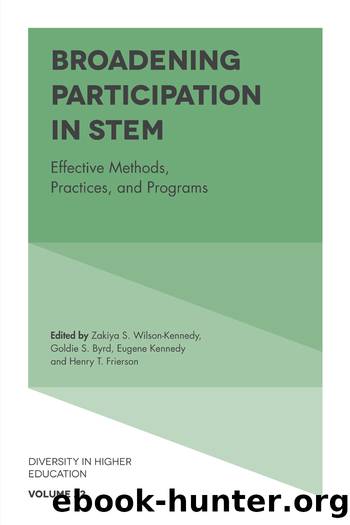Broadening Participation in STEM by Wilson-Kennedy Zayika;Byrd Goldie S.;Kennedy Eugene;Frierson Henry T.;

Author:Wilson-Kennedy, Zayika;Byrd, Goldie S.;Kennedy, Eugene;Frierson, Henry T.;
Language: eng
Format: epub
Publisher: Emerald Publishing Limited
Published: 2019-01-31T00:00:00+00:00
CREATING A COMMUNITY IN FIRST- AND SECOND-YEAR CHEMISTRY COURSES
The Gateway and Bottleneck
Introductory general chemistry courses, traditionally taken by chemistry and biochemistry majors in their first year and other science and non-science majors in their second year, mark studentsâ first experience grappling with their potential to navigate the STEM curriculum. With the belief that mastery of chemical knowledge shapes oneâs ability to comprehend other scientific subjects, the challenges encountered in introductory courses often compel students to leave the major. These observations imply that general chemistry courses aim to separate those who are prepared for the rigors of a STEM course of study from those who are not. General chemistry has long been considered the gatekeeper designed to challenge studentsâ readiness for what comes next academically. Likewise, organic chemistry is regarded as the course designed to determine whether a student can continue as a STEM major and persist in a STEM career, particularly those related to health care. The high demand for this course combined with the inherent difficulty and abstract nature of its concepts results in low success rates, creating a bottleneck in the curriculum. Gateway and bottleneck courses have typically served to reduce the number of STEM majors, not just chemistry majors, at many institutions. Given the centrality of chemistry to other sciences and the need to improve diversity in STEM, faculty in the department are reshaping the curriculum to assist students in overcoming the hurdles of the first- and second-year curriculum. Targeting studentsâ emerging scientific thinking at this level should translate into a skill set that will serve students well in subsequent science courses (Smith, Chungh, Sadouq, & Kandiah, 2015; Tai, Sadler, & Loehr, 2005). This section details strategies to address studentsâ developmental needs at these critical junctures.
Download
This site does not store any files on its server. We only index and link to content provided by other sites. Please contact the content providers to delete copyright contents if any and email us, we'll remove relevant links or contents immediately.
The Art of Coaching Workbook by Elena Aguilar(50130)
Trainspotting by Irvine Welsh(21050)
Twilight of the Idols With the Antichrist and Ecce Homo by Friedrich Nietzsche(18312)
Fangirl by Rainbow Rowell(8807)
Periodization Training for Sports by Tudor Bompa(7936)
Change Your Questions, Change Your Life by Marilee Adams(7389)
This Is How You Lose Her by Junot Diaz(6463)
Asking the Right Questions: A Guide to Critical Thinking by M. Neil Browne & Stuart M. Keeley(5369)
Grit by Angela Duckworth(5303)
Red Sparrow by Jason Matthews(5204)
Paper Towns by Green John(4812)
Room 212 by Kate Stewart(4745)
Ken Follett - World without end by Ken Follett(4453)
The Sports Rules Book by Human Kinetics(4087)
Housekeeping by Marilynne Robinson(4075)
Double Down (Diary of a Wimpy Kid Book 11) by Jeff Kinney(3941)
Papillon (English) by Henri Charrière(3924)
The Motorcycle Diaries by Ernesto Che Guevara(3796)
Exercise Technique Manual for Resistance Training by National Strength & Conditioning Association(3791)
